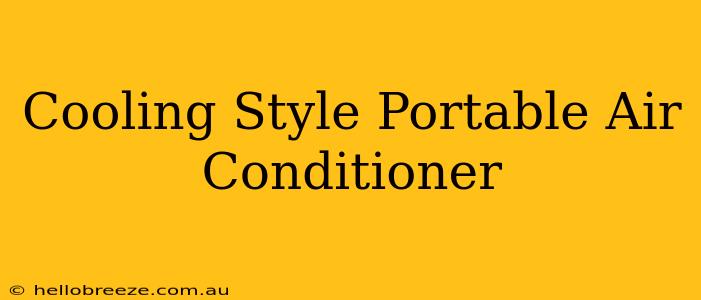Summer heat got you down? A portable air conditioner can be your saving grace, offering refreshing cool air wherever you need it. But with so many options available, choosing the right one can be overwhelming. This guide will walk you through everything you need to know about cooling style portable air conditioners, helping you find the perfect fit for your needs and budget.
What is a Cooling Style Portable Air Conditioner?
A portable air conditioner (also known as a portable AC unit) is a self-contained cooling system designed for easy mobility. Unlike window units, they don't require permanent installation. They're ideal for:
- Apartments and rentals: Where installing window units might be prohibited or impractical.
- Homes with multiple rooms: Easily move the unit to wherever you need the most cooling.
- Offices and small spaces: Providing personalized climate control.
- Dormitories and temporary housing: Offering a convenient cooling solution.
The "cooling style" refers to the specific technology used to cool the air. Most portable air conditioners use evaporative cooling or refrigeration (using a compressor). We'll explore these further below.
Types of Cooling Style Portable Air Conditioners
1. Evaporative Cooling Portable Air Conditioners
These units work by evaporating water to cool the air. They're generally:
- Less expensive than refrigeration units.
- More energy-efficient, consuming less electricity.
- Best suited for dry climates. They are less effective in humid environments.
- Quieter in operation compared to refrigeration units.
However, evaporative coolers add humidity to the air, which can be undesirable in already humid conditions. They also don't cool as effectively as refrigeration units.
2. Refrigeration Portable Air Conditioners
These units use a compressor and refrigerant to cool the air, similar to a central air conditioning system. They are:
- More effective at cooling even in humid environments.
- Suitable for various climates.
- More expensive than evaporative coolers.
- Generally louder due to the compressor.
- Consume more energy.
Key Features to Consider When Buying
When selecting your portable air conditioner, consider these crucial factors:
- BTU (British Thermal Units): This rating indicates the cooling capacity. Higher BTU means more powerful cooling for larger spaces. Consider the square footage of the room you'll be cooling.
- Energy Efficiency (EER or SEER): A higher EER or SEER rating means the unit uses less energy to produce the same amount of cooling. This will save you money on your electricity bill.
- Noise Level: Check the decibel rating. Lower decibels mean quieter operation.
- Size and Weight: Ensure the unit is manageable to move around as needed.
- Features: Look for additional features like a timer, remote control, multiple fan speeds, and dehumidification.
- Water Tank Capacity (for Evaporative Coolers): Larger tanks require less frequent refilling.
- Hose Length (for Refrigeration units): The exhaust hose needs to vent hot air outside, so consider the length required for your setup.
Maintaining Your Portable Air Conditioner
Proper maintenance prolongs your unit's lifespan and ensures optimal performance. Remember to:
- Regularly clean the filter: A dirty filter restricts airflow and reduces efficiency.
- Empty the water tank (for evaporative coolers): Prevent water buildup and potential damage.
- Clean the condenser coils (for refrigeration units): Dust buildup hinders cooling efficiency.
- Store properly during off-season: Protect your unit from dust and moisture.
Choosing the Right Cooling Style Portable Air Conditioner for You
Ultimately, the best portable air conditioner depends on your individual needs and preferences. Consider your budget, the climate you live in, the size of the space you need to cool, and your desired level of cooling power. Carefully weigh the pros and cons of evaporative and refrigeration cooling styles to make an informed decision. Staying cool and comfortable this summer is within reach!

